|
|
|||||
 |
 |
|
Tarot 101 Road to Enlightenment |
|
|
|
|
|||||
 |
 |
|
Tarot 101 Road to Enlightenment |
|
|
| Tarot 101 -Road
to Enlightenment 1. There are 78 cards in the standard tarot deck. 2. One part of the deck is very much like playing cards. There are 4 suits. Each suit consists of 10 cards, numbered from ace to 10, plus 4 picture cards: total 14 x 4, 56. 3. There are 22 major cards, numbered from 0 (the Fool) to 22 (the Universe, or the World Dancer.) First, let's now take a quick romp through the 22 major tarot cards. |
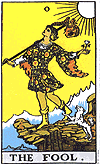 |
We start with the fool. TheFool
is so much at the beginning of his spiritual journey that his card doesn’t
even have a number. Zero!. What is with this fool? Is he really foolish? The old court jesters were called fools but most of the time they were pretty cunning. They knew just how far to take their foolery--take it too far and the king might just cut off their head. This fool could be a carefree, unformed youth. The fool has an instinctive side, he doesn't need to think about things too much. He is a part of the universe, like a child is, and the universe is protecting him. He carries a stick like a tramp might carry a stick. . |
| That stick is actually a magic wand but the fool does not know it yet. Parsifal was a fool when he first made an appearance, but then he went away on a long quest and came back a wise enough man to be able to lead the grail knights and to heal the old king. |
| The Magician, in some decks, is depicted as a sort of street magician, someone who might eat fire or do sleight of hand tricks. But what we have here is clearly the ritual magician, a practitioner of ceremonial magic. He has before him his 4 principle tools: the cup, the wand, the sword and the pentacle.These are the tools for transformation. In contrast to the fool's serendipity, the magician is very focused. He is a symbol of self conscious awareness and power of the will. |
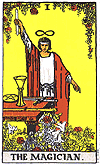 |
|
|
In the High Priestess we have a female magician. She brings the same energy as the magician, but her energy is the feminine energy: a sense of mystery, psychic forces, inner wisdom at its deepest level.The pool of water lying behind her and the blue in her robes could be the subconscious. The high priestess gives us one answer to the struggle: self contained inner wisdom: a quiet retreat.This is a character with a strong inner life. She sits between two Kabbalistic symbols. the dark pillar of “severity” and the white pillar of “mercy.” |
| The Empress is the female archetype in full bloom--much more earthy than the High Priestess; in fact, the fertile, giving earth mother, seated in an earth setting. Venus, a symbol of sensual love, is by her throne, and this is also magic--she also has a magic wand, in the Rider-Waite deck. The Empress is the first card in what R. Pollack calls the "earthly series" - the symbol of the fertility of feminine energy. |
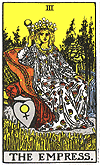 |
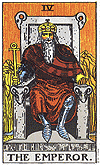 |
The Emperor, is next. He is
a symbol or archetype of earthly authority. (I hope and pray that he will be wiser than the current heads of the top-dog countries). The Hierophant (sometimes called the Pope) is, a religious figure, an archetype of the authority of the church---king and church used to go hand in hand; “Divine Right of Kings,” all that stuff. |
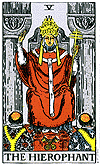 |
|
|
The Lovers. You have 3 figures here- a man, a woman and an angel. One interpretation is that the figures, the conscious and the subconscious, join together to give us the superconscious, the energy of the unconscious brought out and transformed into a higher state. These lovers are Adam and Eve-like: you see (Ryder-Waite) the serpent climbing up the tree in back of the woman. THE Garden (capital G) was supposed to contain 2 trees--the tree of the knowledge of good and evil (the fruit tree) and the tree of life. |
| The Chariot is a card of
personal maturity, strength and Will—especially Will. Here we have still
another figure with a magic wand, balancing and commanding--by an act of
Will--two polarities. The black sphinx and the white sphinx are the same as the priestess’ black pillar and white pillar. (The balance lies in the middle pillar- Israel Francis Regardie, if you want to read more about the Middle Pillar). |
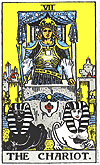 |
| There follows a series of cards that Pollack
calls the “turning within” cards.: Strength, the Hermit, the
Wheel of Fortune, Justice, The Hanged Man, Death,
and Temperance. To find answers to all the questions that really matter, one has to turn within. One has to have a certain degree of maturity and inner knowledge (information!) to do this. That means you don’t hem and haw and spout off every rationalization and defense mechanism in the book! One thing I’ve learned the hard way: people seldom really want advice, especially when they ask for it! Sure, they might want legal advice, or advice on how to boot up a dead computer! But they don’t really want things to mess up their minds! |
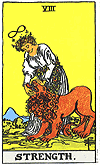 |
Strength is the animal nature tamed. All of us are part animal, and we have to tame and control that part of our own natures, so that this is not the part of our personalities that leads the rest of us. Strength, card 8, is right under the magician, card 1, and both figures have the infinity sign, the lemniscape, the sideways 8, over their heads. So there is suggested affinity between the 2 cards. The self conscious directing of the will in order to tame that animal self. TAME, never to to stamp out the animal. We need to give our animal nature its due, to integrate it within ourselves (unlike Hesse’s “Steppenwolf”). It is this animal nature which gives us our vitality. But it must be under our rationality, under Will. |
| The Hermit is the wise old man, the lamp bearer. He too has his magic wand. The Hermit is self-sufficient. He does not need a lot of people chattering him up in order to garner his self esteem. Sometimes we all have to withdraw in order to find ourselves. The Hermit also represents a transition. He is withdrawing into meditation and the various psychic disciplines, and by this withdrawal, one is able to be alone with the silence so that one will be receptive, so that one will be able to hear the voice of the gods when they speak to us. We also get knowledge this way—er, information! | 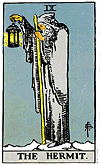 |
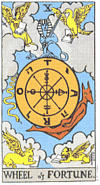 |
The Wheel of Fortune has a
question for us. What about the random events of the universe, what sense
are we to make of these? The suggested answer is that even the seemingly
random events are part of universal law, of universal life force; there is a
oneness. Around the wheel we find the same zodiac representations that we
will find on the last card--the bull, the lion, the eagle and the man. These
stand for the fixed signs of the zodiac, the four writers of the Gospel,
etc. Revelations mentions “And before the throne there was a sea of glass like unto crystal: and in the midst of the throne, and round about the throne, were four beasts full of eyes before and behind. |
| And the first beast was like a lion, and the second beast like a calf, and the third beast had a face as a man, and the fourth beast was like a flying eagle. And the four beasts had each of them six wings about him; and they were full of eyes within: and they rest not day and night.” (John) (Let’s just call this one a mystery!) |
|
|
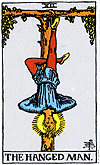
|
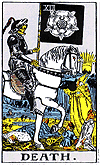
|
The balanced scales on the
Justice card point to the balance between understanding and action,
between mercy and severity. In the Hanged Man we see someone who has surrendered to the rhythms of life and therefore has become calm and wise. In the Death card we see that both a crowned figure as well as a more ordinary mortal have been ravished, since death does not discriminate. |
| We really have to learn to accept death before we can fully appreciate life. But more to the meaning of the card, parts of us often need to die so that other parts can come into existence. Some old, unproductive ways of looking at things have to die so that we can move on to more enlightened ways of looking at things--so that we can grow. Many tarot interpreters tell us that the death card doesn’t really mean death, but merely change, a type of transformation, a psychic housecleaning. (Sometimes though, to comment on Freudian symbolism---a cigar is just a cigar….) |
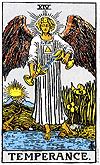 |
Temperance is the ability to combine the different sides of life, to synthesize things. It can be seen as a combining of the elements in the personality, of becoming whole. This character, the angel of temperance, has one foot on solid earth and the other foot in those flowing mysterious waters. Pouring water from one cup to another, we again see some kind of magical transformation going on. At this point in our own travels along the major cards, we also would be readying ourselves for a transformation….being able to combine the different sides of life and synthesize things, becoming whole, accepting the shadow and parts of our self that we were not heretofore able to deal with. Accepting the parts of ourself that we can’t stand, not denying that they exist. |
| So after the inner journey of Strength, the Hermit, the Wheel of Fortune, Justice, the Hanged Man, Death and Temperance, we move to 7 Great Journey cards: (per Pollack) the Devil, the Tower, the Moon, the Star, the Sun, Judgment, and the World - also called the Universe. The Devil, the Tower and the Moon are particularly rough spots in the journey, but in between these, there are more restful cards to let us catch our breath. |
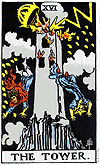 |
The Tower. The Tower is our Damascus experience, after which nothing again can ever be the same, after which there is no turning back on the path. Whatever tower we have used to protect ourselves, to insulate ourselves, keeping on with a negative situation in life even though we might be miserable, being so afraid of what we are most afraid of --change!--that we stay in our tower and hope it will protect us, the ivory tower, the tower of Babel, insulated belief systems --lightning strikes. The façade crumbles.After this lightening strikes us, metaphorically, we can't go back to old, limiting ways of doing things anymore. We can't go back to old destructive relationships. We’ve burned the bridge! And yet, at this point in our journey |
| toward illumination, we have moved past the past,( if our problem was other people, we’ve thrown the bums out) but can’t yet see our future It is very scary right here. |
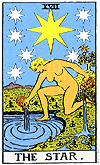 |
The Star-- After the storm and stress of the Tower, we have a peaceful resting place, the Star, much as after the Death card, we had Temperance. In the Star, water is being poured onto the land as well as into the water, showing that the energy freed by the Tower is directed both without and within. You notice in the Star that the foot of the figure does not actually enter the water. The collective unconscious has not yet been entered. But it is getting stirred up.The figure in the card is an androgyne, which could symbolize blending of male and female energies, moving from separateness to wholeness. |
| The Moon-- The Star gave us a chance to catch our breath, but now comes one of the most tumultuous cards of all the trumps--the Moon. The Star is a card of meditation, which has stirred up the waters , stirred us up inside. So what happens after all this stirring? What we have in the Moon is the bursting forth of our unconscious impulses in a way that forces us to deal with them. The beast has escaped. We might experience strange emotions, dreams, fears or hallucinations. The Moon is an excited, stimulated bursting-out of all of our demons, even the ones that we didn’t know about! These experiences, these parts of the self which we have always tried to stuff, can not, after all, be denied. | 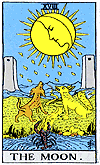 |
| The dog and the wolf in the Moon card can be equated with the animal self. We saw in card 8, Strength, the animal nature tamed; but here there is no taming. The crawfish, crawling out of the primordial deep, is all those nameless demons that are our most universal fears. The polarities are again suggested by the two towers on either side. |
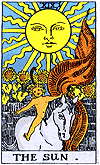 |
The Sun: After the test of the Moon, the Sun shines forth as a joyous release--and a preparation for the death and rebirth that are to occur in the next two cards, Judgment and the World. Death and rebirth is a constantly recurring theme in the mythologies of the world, from Christianity to the fertility stories of the slaughter of the old king who can then fertilize the land. The Sun shows a person alive with a childlike joy, with a freedom. It is sometimes said to be the hermit on a higher octave, as both have their special freedom. Whether right or crazy it has always suggested to me Christ's triumphal ride into Jerusalem.(a ride that led directly to his death). Joy, happiness, and a great sense of the beauty of life are what the Sun is all about. |
| Then comes Judgment.
The trumpet call is loud enough to raise the figures from the dead. People
rising up out of their coffins. Total renewal of life. What this call is, is
a call from deep inside ourselves , to dissolve our personalities--at some
level at least-- and to become part of the one, part of the whole. It is a
coming to terms with past experiences and a going beyond those experiences. Some of us do trudge through our lives dead to so much of the joy and wonder all around us. Others, or sometimes the same people, can also be dead to the horrors of war, our destruction of the planet, and man’s inhumanity to man |
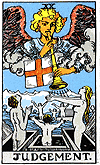 |
| Both joy and tragedy are part of life, and
while we embrace the joy, we also acknowledge the dark side and try to make
some sense of that, and to help where we may. I once heard a sermon where a priest named Rev. Sloan said that it is easy enough (for a believer) to find God in the Mass; it is much more difficult to find God in the MESS of our hurting, frightened and depressed world. |
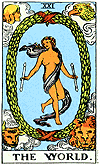 |
The World (or the World
Dancer or the Universe): Finally, reaching the final card of our
road to enlightenment, we see a figure cradled in the oval shape which could
be the world egg--balancing 2 magic wands, dancing the dance of life. And
once more--as in the Wheel of Fortune card, the 4 heavenly creatures of the
eagle, the lion, the bull and the man, the water-
bearer, are in each corner. We have here reached a state of our unconscious now known consciously; we are able to integrate any parts of ourselves which we had previously suppressed. Yeats asks in his poetry, “How can we know the dancer from the dance? Well, here the dancer has become the dance. |
| Our inner self is unified with the outer forces of all life. All potentials are realized. The self is everywhere in all things. All men/women are one. And we connect to every God of light that anyone has ever prayed to. |
|
|
|
|
|
Wands Cups Swords Pentacles |
| Let's consider the 4 suits. Wands, Cups, Swords, Pentacles. (Various decks call them different names; wands are sometimes called staves or rods; pentacles are sometimes called disks or coins). These suits have various correspondences. Understanding the elements will help in understanding the minor cards, the four suits. |
| Wands |
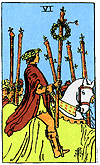 |
Wands is the element of
fire, and fire is the passion and energy of our existence. Look at how we
refer to fire in daily usage “burning with desire” connotes an energized
state. “I’m all fired up! (ready to go!) seems positive. “I’m burning up
(with anger).” Energized still, but not so pleasant. Burnt out! (very sad).
Elements are neither good nor bad, but usage, under will, makes them so. One
likes to sit before a fire place. One wants to stay out of burn units! Wands are full of fiery activities, or fiery people, quick, energetic, bursting, beginnings. Please note that fiery energy is not always sustained, but tends to flame up and flare out. |
| Wands, being fire, also represents our
spiritual side. We do after all speak of the Divine Spark . Eliot’s “Little
Gitting” refers to fire as the Holy Ghost, a penitential fire that seers
away what we in ourselves find undesirable. A purified self remains Wands tend to show the way the inner fire manifests itself in our everyday life. Wands is living, action, the joy of movement, the life-giving power of the Sun. The cabalistic world is Atziluth, the highest and most abstract world, sometimes called the archetypal world. Kether on the Tree of Life. |
| ************************************************************************ |
| Pentacles |
| These are variously called disks, coins,
circles, stones. The element is earth. Pentacles stand for the earth
we live in, groundedness, and the things we require to live. For many of us
it is work, money and use of our time. There is a definite relationship
between these three things, especially for those of us who have ever been
wage slaves. But we are not just grounded in our work, we are grounded in all the things of everyday creation. Some tarot decks like the Marseilles deck see pentacles only as coins, the material side of life, getting money. The Pentacle is a magical sign. It symbolizes the magic of this world, the magic that is all around us. |
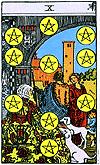 |
| Having our feet flat on the ground,
(hopefully, not our flat feet!) having a close relationship to this ofttimes
troubled globe, on which we live, breathe and have our being.. Again, we
look at vernacular usage.We can be earthy, some people are earth-mothers; we
tell people to get down to earth. Starting at the ground floor, that sort of
thing. Having your ear to the ground. In some instances, a person can too plodding, too literal, too Taurus, too planted. The worst type of plantedness IMHO is to be planted to a belief, even when new information (call it knowledge if you want to; I like just to call it information) comes along, perhaps even in the form of a paradigm shift; but the “planted ones” or “planted institutions” will never revise their belief! The cabalistic world is Assiah, the active world in which we live; Malkuth on the Tree of Life. |
| ************************************************************************ |
| Cups |
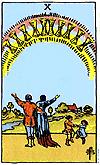 |
The element is water. Cup is a powerful symbol. Drinking a toast to one’s health or happiness; celebrating with wine; drinking in the New Year with champagne—which must necessarily be consumed out of some kind of vessel. The communion cup at the altar (a magical use of cups)! And just as magical for me, that first cup of steaming java in the morning! The unusual thing about the element water is that water only hold is shape in a cup, or some kind of container. Cups are receptive. As fire represents action, cups represent receptivity. Cups represent formlessness and passivity, not always in a negative way, but in the way that in order to grow inwardly, you need this formlessness. |
| You can not be rigid. Cups represent our
emotional side, that which lets us feel, that which lets us love, that which
lets our heart leap up at a beautiful sunset.The suit of cups basically
shows an inner experience of love, imagination, joy, peace, harmony and
wonder. We can't really say that we talk about watered down as the opposite
of fired up! But we do talk about watering, cultivating our gardens, a
nurturance that must exist before the fiery sun can draw the seed from the
ground. We win cups (the Ryder Cup, e.g.) We can also be “in our cups” i.e.
drunk. Are there negative things about cups? Yes. The water element can get out of control just like fire. We can burn; we can drown. At the extreme, cups can represent too much passivity. In the tarot, the Knight of Cups might not be the most effective Knight, as contrasted with the fiery Knight of Wands. Knights are supposed to be fired up. Or not. Still waters run deep. Tears are water--the idea of feeling very deeply. Tears of sorrow, tears of joy. The cabalistic world is Briah, the creative world. Chokmah and Binah on the Tree of Life. |
| ************************************************************************ |
| Swords |
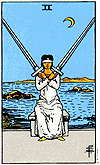 |
Swords is a difficult suit,
signifying among other things, pain, anger and destruction. Yet a sword can
also symbolize cutting through complicated problems, cutting through
illusion. Hurtful words are swords. Just stick an s in front. In fact, words
are probably the strongest type of swords if spoken harshly. (How many of us
can remember some third grade teacher who cut us badly—with words?) Swords can also be very helpful Their element is air, a wind that is seen as very close to spirit. Wind, spirit, all relate to the world "breath". Swords symbolize mental sharpness. Just as the air is blowing, twisting and turning, the mind is also twisting, turning things over. Thinking. |
| Pollack writes that one problem of the
suit of swords is the Hamlet problem, where the mind sees so many sides to a
situation, so many possible solutions, that the result is inaction. On the cabalistic Tree, swords are the formative world, Yetzirah, and sephirah 4 to 9. Chesed, Gevorah, Tipareth, Netzach, Hod and Yesod. |
| -Dorian Borsella (ref. R. Pollack, R. Wang, G. Knight) |